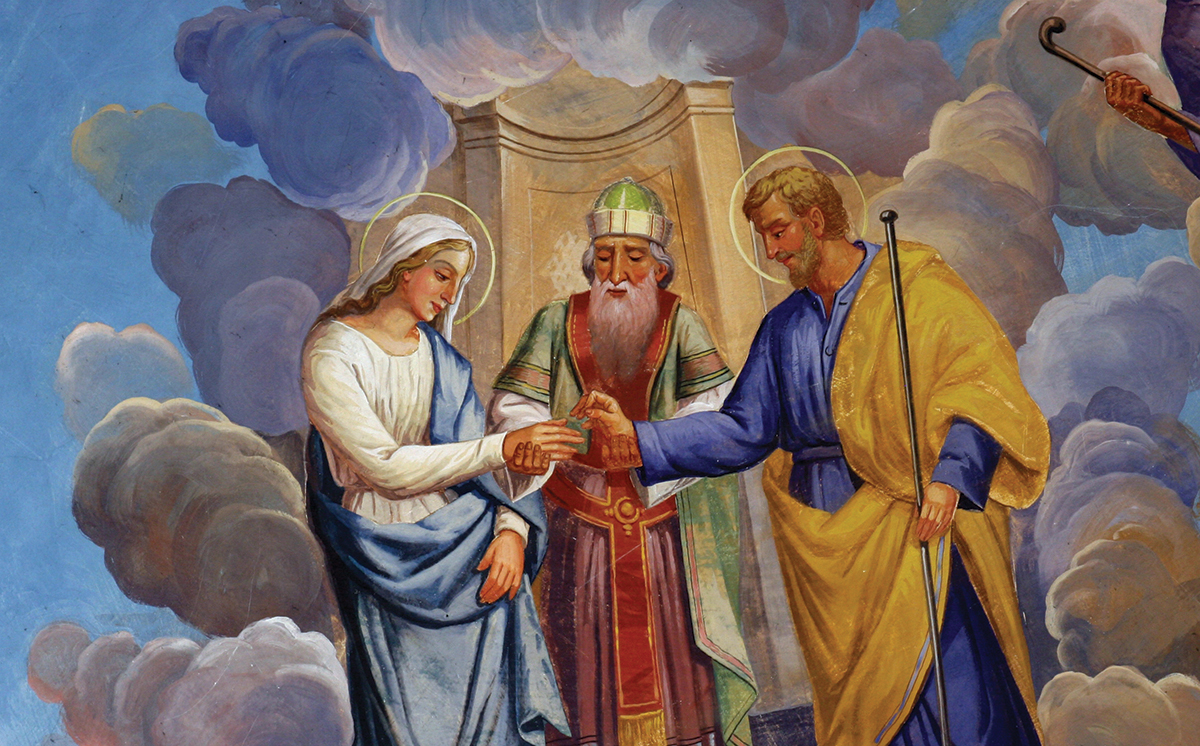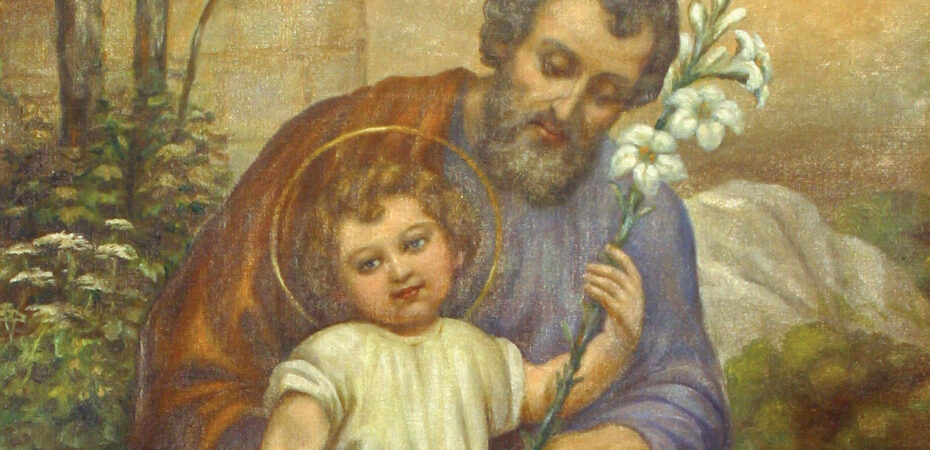St. Joseph: A Model for Priestly Fatherhood
We serve as spiritual guardians of the faithful
Robert Fastiggi Comments Off on St. Joseph: A Model for Priestly Fatherhood
The Second Vatican Council affirms the fatherhood of priests, and it exhorts them, “as fathers in Christ,” to “take care of the faithful whom they have begotten by baptism and their teaching” (Lumen Gentium, No. 28). Priests are configured to Christ, the High Priest, and they exercise their priesthood in his name. On the solemnity of St. Joseph, it is important to realize that Jesus, the High Priest, had an earthly father, who — though not his biological father — nevertheless served as his model of human fatherhood. In his acquired human knowledge, “Jesus advanced [in] wisdom and age and favor before God and man” (Lk 2:52). In acquiring human knowledge about fatherhood, Our Lord’s model was St. Joseph.
Pope St. John Paul II, in his 1989 apostolic exhortation, Redemptoris Custos, highlights the authentic fatherhood of St. Joseph within the Holy Family: “In this family, Joseph is the father: His fatherhood is not one that derives from begetting offspring, but neither is it an ‘apparent’ or merely ‘substitute’ fatherhood. Rather, it is one that fully shares in authentic human fatherhood and the mission of a father in the family. This is a consequence of the hypostatic union: humanity taken up into the unity of the Divine Person of the Word-Son, Jesus Christ. Together with human nature, all that is human, and especially the family — as the first dimension of man’s existence in the world — is also taken up in Christ. Within this context, Joseph’s human fatherhood was also ‘taken up’ in the mystery of Christ’s Incarnation” (No. 21).
If Joseph could serve as a model of human fatherhood for Christ, he is a most fitting model of fatherhood for priests. There are several reasons for this. The first is that St. Joseph’s fatherhood towards Christ — although not biological — was nonetheless real. Pope Leo XIII, in his 1889 encyclical Quamquam Pluries, notes that by giving Joseph to Mary as her spouse, God made him “the guardian of the Son of God and reputed as his father among men” (No. 3). It followed, therefore, that “the Word of God was humbly subject to Joseph, that he obeyed him, and that he rendered to him all those offices that children are bound to render to their parents” (No. 3). Joseph was the only man on earth that Jesus could call Abba — that is, father.
Spiritual Guardians
Joseph was the guardian of the family of Nazareth, which can be considered the Church in miniature. Joseph also was the guardian of Christ. Priests are to be spiritual guardians of the people entrusted to their care, and they are to foster the growth of Christ in the souls of people. They should exercise spiritual fatherhood over the faithful in imitation of Joseph, who cared for Jesus and Mary with tender, self-sacrificing love.
In a homily of March 19, 1966, Pope St. Paul VI said that Joseph expressed his fatherhood “by making his life a sacrificial service to the mystery of the incarnation and its redemptive purpose. He employed his legal authority over the Holy Family to devote himself completely to them in his life and work. He turned his human vocation to domestic love into a superhuman oblation of himself, his heart and all his abilities, a love placed at the service of the Messiah who was growing to maturity in his home” (referenced by Pope Francis in his 2020 apostolic letter, Patris Corde, No. 1).

St. Joseph, therefore, serves as a model of the self-sacrificing paternal love priests should have toward the faithful. Even though Joseph was not the biological father of Jesus, he cared for him and the Virgin Mary as a true father and husband who protects and sacrifices for his family. In Patris Corde, Pope Francis explains how bishops and priests become fathers when they accept the responsibility for the lives of others: “Fathers are not born, but made. A man does not become a father simply by bringing a child into the world, but by taking up the responsibility to care for that child. Whenever a man accepts responsibility for the life of another, in some way he becomes a father to that person.
“Children today often seem orphans, lacking fathers. The Church too needs fathers. Saint Paul’s words to the Corinthians remain timely: ‘Though you have countless guides in Christ, you do not have many fathers’ (1 Cor 4:15). Every priest or bishop should be able to add, with the apostle: ‘I became your father in Christ Jesus through the Gospel’ (ibid.). Paul likewise calls the Galatians, ‘My little children, with whom I am again in travail until Christ be formed in you!” (4:19)” (No. 7).
Fatherly Tenderness
Pope Francis also highlights Joseph as a model of fatherly tenderness. In his Jan. 19, 2022, General Audience, Pope Francis stated that “there is great tenderness in the experience of God’s love,” and Joseph transmitted this tender love to Jesus. Priests should also manifest tender love toward sinners.
There are other ways in which St. Joseph serves as a model for priestly fatherhood. He is the most chaste spouse of the Blessed Virgin Mary, and he shows how continence for the kingdom of God “not only does not contradict the dignity of marriage but presupposes it and confirms it,” writes Pope John Paul II in Familiaris Consortio (cf. No. 16). Joseph provides a model of how spousal love can be expressed while observing continence.
In Redemptoris Custos, John Paul II writes: “Through his complete self-sacrifice, Joseph expressed his generous love for the Mother of God, and gave her a husband’s ‘gift of self.’ Even though he decided to draw back so as not to interfere in the plan of God which was coming to pass in Mary, Joseph obeyed the explicit command of the angel and [took] Mary into his home, while respecting the fact that she belonged exclusively to God” (No. 20).
Embracing Chaste Celibacy
Priests who embrace chaste celibacy for the kingdom of God can find in St. Joseph an inspirational model of a man who loved the Blessed Virgin Mary in complete continence while exercising self-sacrificing love in obedience to the plan of God.
Priests, in fact, are called to have a special love for the Virgin Mary. In his 1950 apostolic exhortation, Menti Nostrae, Pope Pius XII states, “Our Lady loves everyone with a most tender love, but she has a particular predilection for priests who are the living image of Jesus Christ” (No. 142). During the flight into Egypt and other challenges, St. Joseph was sustained by his love for the Virgin Mary and her divine son, Jesus Christ. As spiritual fathers, priests must also be sustained by their love for Mary and Jesus.
The spiritual fatherhood of Joseph embodies a love that is chaste and non-possessive. Pope Francis observes that Joseph is called “most chaste” because he “knew how to love with extraordinary freedom. He never made himself the center of things. He did not think of himself, but focused instead on the lives of Mary and Jesus” (Patris Corde, No. 7). Pope Francis also notes that “in every exercise of our fatherhood, we should always keep in mind that it has nothing to do with possession, but is rather a ‘sign’ pointing to a greater fatherhood. In a way, we are all like Joseph: a shadow of the heavenly Father” (No. 7).
Interior Strength
St. Joseph was a man of prayer, courage and quiet virtue. Scripture describes him as dikaios, righteous or just (cf. Mt 1:19). Priests can find in Joseph a model of a man of interior strength, cultivated by prayer.
Pope St. John Paul II states that “the total sacrifice, whereby Joseph surrendered his whole existence to the demands of the Messiah’s coming into his home, becomes understandable only in the light of his profound interior life” (Redemptoris Custos, No. 26). Joseph is a model of prayer and service, and serves as a model of Eucharistic devotion. Just as St. Joseph cared for the Christ Child, priests care for Christ in the holy Eucharist. They lift up Christ in their hands just as Joseph lifted the Infant Jesus in his fatherly hands.
Work of Salvation
Finally, Joseph is a model of spiritual fatherhood rooted in work. Pope Pius XII established the feast of St. Joseph the Worker in 1955 as a testimony to the dignity of human labor. In Patris Corde, Pope Francis reminds us, “Work is a means of participating in the work of salvation, an opportunity to hasten the coming of the Kingdom, to develop our talents and abilities, and to put them at the service of society and fraternal communion” (No. 6). In Redemptoris Custos, Pope John Paul also notes, “Work was the daily expression of love in the life of the Family of Nazareth” (No. 22). Work serves “the sanctification of daily life … ‘St. Joseph is the model of those humble ones that Christianity raises up to great destinies … he is the proof that in order to be a good and genuine follower of Christ, there is no need of great things — it is enough to have the common, simple and human virtues, but they need to be true and authentic’” (No. 24).
Just as St. Joseph exercised his fatherhood in humble service and work, so priests should exercise their fatherhood in loving service to the People of God. Like Joseph, they should serve the faithful with a chaste love, a non-possessive love, a love that is sustained by intimacy with Jesus and Mary.
ROBERT FASTIGGI, Ph.D., is a professor of systematic theology at Sacred Heart Major Seminary in Detroit. He is former president of the Mariological Society of America.
…………………………………………………………………………………………………………………………………………….
Joseph, a tender and loving father
We can sense the role of Joseph and his love for Jesus in Pope Francis’ apostolic letter Patris Corde: “Joseph saw Jesus grow daily ‘in wisdom and in years and in divine and human favor’ (Lk 2:52). As the Lord had done with Israel, so Joseph did with Jesus: He taught him to walk, taking him by the hand; he was for him like a father who raises an infant to his cheeks, bending down to him and feeding him (cf. Hos 11:3-4)” (No. 2).
……………………………………………………………………………………………………………………………………………..





